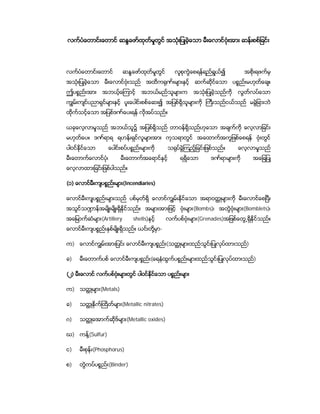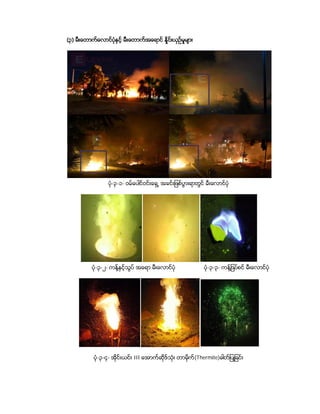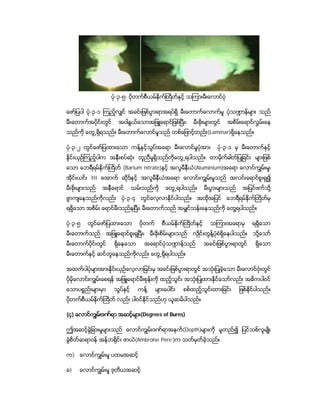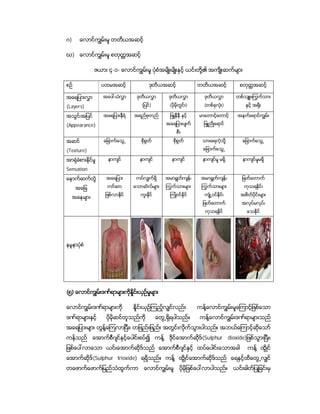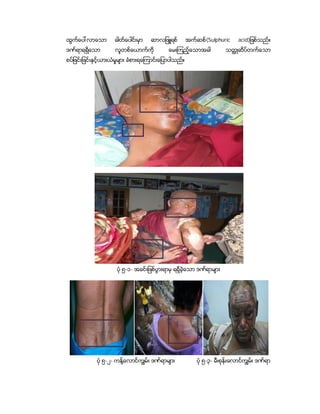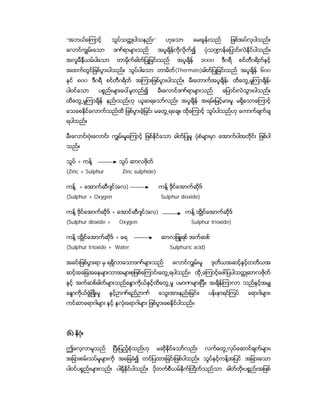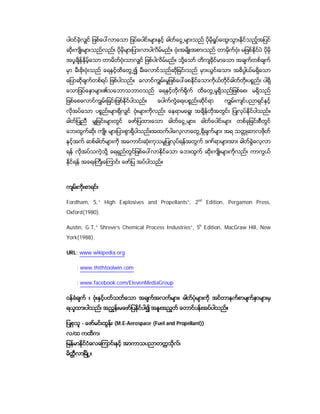Rallybombanalysis
- 1. ááá¹áá¶á±áá¬áá¹á¸á±áá¬áá¹ áááµá±áá¬á¹áá¯áá¹áááá¼áá¹ á¡áá¶á¯á¸á»áá³áá²á·á±áᬠáá®á¸á±áá¬áá¹áá¶á¯á¸á¡á¬á¸ ááá¹á¸á á á¹á»ááá¹á¸ ááá¹áá¶á±áá¬áá¹á¸á±áá¬áá¹ áááµá±áá¬á¹áá¯áá¹áááá¼áá¹ áá°á á¯áá¼á²á±á ááá¹ááá¹áá¼áá¹á á¡á áá¯á¸áááá¹áá½ á¡áá¶á¯á¸á»áá³áá²á·á±áᬠáá®á¸á±áá¬áá¹áá¶á¯á¸ááá¹ á¡ááááá¯áá¹á¸ááºá¬á¸áá½áá¹á· ááá¹ááá¯áá¹á±áᬠáá á¥áá¹á¸ááá¯áá¹á±ááºá á¤áá á¥áá¹á¸ á¡á¬á¸ á¡ááá¹á·á±á¾áá¬áá¹á· á¡ááá¹ááá¹áá°ááºá¬á¸á á¡áá¶á¯á¸á»áá³áá²á·ááá¹ááᯠáá¼áá¹ááá¹á±áᬠáá¼áºáá¹á¸ááºáá¹ááá¬áá½áá¹ááºá¬á¸áá½áá¹á· áá°á¸á±áá«áá¹á¸á á á¹á±áá¸á á¡á»áá á¹áá½ááá°ááºá¬á¸ááᯠááá®á¸ááá¹ááá¹ááá¹ ááá¼á²á»áá¬á¸áá² ááá¯áá¹ááá¹á·á±áᬠá¡á»áá á¹ááá¹á±áá¸ááá¹ áá¯áá¡áá¹ááá¹á ááá¯á±áá·áá¬ááááá¹ á¡ááá¹áá°á á¡á»áá á¹áá½áááá¹ áá¬ááá¹áá½áááá¹áá¯á±áᬠá¡ááºáá¹ááᯠá±áá·áá¬á»ááá¹á¸ ááá¯áá¹á±áá ááá¹áá¬á áááá¹á¸áá½áá¹áá°ááºá¬á¸á¡á¬á¸ áá¯ááá¬áá¼áá¹ á¡á±áá¬áá¹á¡áá°á»áá á¹á±á ááá¹ áá¶á¯á¸áá¼áá¹ áá«ááá¹ááá¯áá¹á±áᬠá±áá«áá¹á¸ á áá¹áá á¥áá¹á¸ááºá¬á¸ááᯠááá¯áá¹áá¼á²á¾ááá¹á·á»ááá¹á¸á»áá á¹ááá¹á á±áá·áá¬ááááá¹ áá®á¸ á±áá¬áá¹á±áá¬áá¹áá¶á¯á áá®á¸á±áá¬áá¹á¡á±áá¬áá¹áá½áá¹á· ááá½áá±áᬠááá¹áá¬ááºá¬á¸ááᯠá¡á±á»áá»áá³ á±áá·áá¬áá¬á¸á»ááá¹á¸ á»áá á¹áá«ááá¹á (á) á±áá¬áá¹áá®á¸ááºáá á¥áá¹á¸ááºá¬á¸(Incendiaries) á±áá¬áá¹áá®á¸ááºá¯áá á¥áá¹á¸ ááºá¬á¸ááá¹ áá á¹áá½áá¹áá½á á±áá¬áá¹áá¼áºáá¹á¸ááá¯áá¹á±áᬠá¡áá¬ááá³á³ááºá¬á¸ááᯠáá®á¸á±áá¬áá¹á±á á¿áá®á¸ á¡áá¼áá¹ááá¬áá¹á¡ááºáá³á¸ááºáá³á¸áá½áááá¯áá¹ááá¹á á¡ááºá¬á¸á¡á¬á¸á»ááá¹á· áá¶á¯á¸ááºá¬á¸(Bombs)á á¡áá¼á²áá¶á¯á¸ááºá¬á¸(Bomblets)á á¡á±á»áá¬áá¹áá¶ááºá¬á¸(Artillery shells)áá½áá¹á· ááá¹áá á¹áá¶á¯á¸ ááºá¬á¸(Grenades)á¡á»áá á¹á±áá¼ááá½áááá¯áá¹ááá¹á á±áá¬áá¹áá®á¸ááºáá á¥áá¹á¸ áá½á á¹ááºáá³á¸áá½áááá¹á ááá¹á¸ááá¯ááá½á¬- á) á±áá¬áá¹áá¼áºáá¹á¸á¡á¬á¸á»ááá¹á¸ á±áá¬áá¹áá®á¸ ááºáá á¥áá¹á¸(ááá³á³ááºá¬á¸ááá¹áá¼áá¹á¸á»áá³áá¯áá¹áá¬á¸ááá¹) á) áá®á¸á±áá¬áá¹áá á¹ á±áá¬áá¹áá®á¸ ááºáá á¥áá¹á¸(á±ááá¶áá¼áá¹áá á¥áá¹á¸ááºá¬á¸ááá¹áá¼áá¹á¸á»áá³áá¯áá¹áá¬á¸ááá¹) (á) áá®á¸á±áá¬áá¹ ááá¹áá á¹áá¶á¯á¸ááºá¬á¸áá¼áá¹ áá«ááá¹ááá¯áá¹á±áᬠáá á¥áá¹á¸ ááºá¬á¸ á) ááá³á³ááºá¬á¸(Metals) á) ááá³á³ááá¯áá¹ááááááºá¬á¸(Metallic nitrates) á¹ á) ááá³á³á±á¡á¬áá¹ááá¯áá¹ááºá¬á¸(Metallic oxides) á) ááá¹á(Sulfur) á) áá®á¸á á¯áá¹á¸(Phosphorus) á ) áá¼á²ááá¹áá á¥áá¹á¸(Binder)
- 2. (á) áá®á¸á±áá¬áá¹á±áá¬áá¹áá¶á¯áá½áá¹á· áá®á¸á±áá¬áá¹á¡á±áá¬áá¹ ááááá¹á¸áá½á¥á¹ááááºá¬á¸ áá¶-á-á- ááá¹á±áá«áá¹ááá¹á¸á±áá½á á¡ááá¹á¸á»áá á¹áá¼á¬á¸áá¬áá¼áá¹ áá®á¸á±áá¬áá¹áá¶á¯ ᯠáá¶á¯-á-á- ááá¹ááá½áá¹á·áá¼áá¹ á¡á±áᬠáá®á¸á±áá¬áá¹áá¶á¯ áá¶á¯-á-á- ááá¹áá»ááá¹á áá¹ áá®á¸á±áá¬áá¹áá¶á¯ áá¶á¯-á-á- á¡áá¯áá¹á¸ááá¹á¸ III á±á¡á¬áá¹ááá¯áá¹áá¶á¯á¸ áá¬ááá¯áá¹(Thermite)áá«áá¹á»áá³á»ááá¹á¸
- 3. áá¶-á-á - ááá¯ááá¹á á®ááá¹ááá¯áá¹ááááá¹áá½áá¹á· áá¾áá¬á¸áá®á¸á±áá¬áá¹áá¶á¯ ᯠá±áá¬á¹á»ááá« áá¶-á-á á¾ááá¹á·áá½áºáá¹á¹ á¡ááá¹á¸ á»áá á¹áá¼á¬á¸áá¬á¡ááá¹áá½á áá®á¸ á±áá¬áá¹á±áá¬áá¹áá áá¶á¯ááá¬áá¹ááºá¬á¸ ááṠᯠáá®á¸ á±áá¬áá¹á¡ááá¯áá¹á¸áá¼áá¹ á¡áá«áá¼áá¹á±áá¬á¡á»áá´á±áá¬áá¹á»áá á¹á¿áá®á¸ á áá®á¸áá¯áá¸ááºá¬á¸áá¼áá¹ á¡á ááá¹á¸á±áá¬áá¹áááá¹á¸á±á ááá¹ááᯠá±áá¼ááá½ááááá¹á áá®á¸á±áá¬áá¹á±áá¬áá¹ááááá¹ áá á¹á±á»áá¬áá¹á·ááá¹á¸(Laminar)áá½áá±áááá¹á áá¶-á-á áá¼áá¹á±áá¬á¹á»ááá¬á¸á±áᬠááá¹ááá½ááá¼áá¡á±áᬠáá®á¸ á±áá¬áá¹áááá¶á¯á¡á¬á¸ ᯠá¹á· á¹ áá¶á¯-á-á áá½ áá®á¸á±áá¬áá¹áá½áá¹á· áá½á¯ááá¹á¸áá½á¥á¹á¾ááá¹á·áá«á á¡áá®á¸ á áá¹áá¶á¯á¸ áá°áá®áááá½áááá¹ááá¯á±áá¼áááá«ááá¹á áá¬ááá¯áá¹áá«áá¹á»áá³á»ááá¹á¸ ááºá¬á¸á»áá á¹ á±áᬠá±ááá®ááá¹ááá¯áá¹ááááá¹ (Barium nitrate)áá½áá¹á· á¡áá°áá®áá®á(Aluminium)á¡á±áᬠá±áá¬áá¹áá¼áºáá¹á¸ááá ᶠá¡áá¯áá¹á¸ááá¹á¸ III á±á¡á¬áá¹ ááá¯áá¹áá½áá¹á· á¡áá°áá®áá®áá¶á¡á±áᬠá±áá¬áá¹á¸áá¼áºáá¹á¸ááááá¹ á¡ááá¹á¸ á±áá¬áá¹á á°á¸áá½á á½ áá®á¸ áá¯áá¸ááºá¬á¸ááá¹ á¡áá®á±áá¬áá¹ ááá¹á¸ááá¹ááᯠá±áá¼áááá«ááá¹á áá®á¸ áá¼á¬á¸ááºá¬á¸ááá¹ á¡á»ááá¹ááá¹ááá¯á áá¼á¬ááºá±áááá¹ááá¯ááá¹á¸ áá¶-á-á áá¼áá¹á±áá·áá¬ááá¯áá¹áá«ááá¹á ᯠá¡ááá¯á¡á»ááá¹ á±ááá®ááá¹ááá¯áá¹ááááá¹áá½ ááá½áá±áᬠá¡á ááá¹á¸ á±áá¬áá¹áá®á¸ááá¹áá¯á¿áá®á¸á áá®á¸á±áá¬áá¹ááá¹ á¡áá½áºáá¹ááá¹á¸á±áááá¹ááᯠá±áá¼áááá«ááá¹á áá¶-á-á ᯠáá¼áá¹á±áá¬á¹á»ááá¬á¸á±áᬠááá¯ááá¹ á á®ááá¹ááá¯áá¹ááááá¹áá½áá¹á· áá¾áá¬á¸á¡á±áá¬áá½ ááá½áá±áᬠáá®á¸ á±áá¬áá¹ááá¹ á¡á»áá´á±áá¬áá¹á á°á¸áá½á¿áá®á¸á áá®á¸áá¯áḠá ááá¹á¸ ááºá¬á¸ááá¹ áá½á³ááá¹á¸áá¼áá¹ááá¶á¯á á¶áá½áá±ááá«ááá¹á ááá¯áá±áá¬á¹ áá®á¸ á±áá¬áá¹ááá¯áá¹á¸ áá¼áá¹ áá½áá±áá±áᬠá¡á±áá¬áá¹áá¶á¯ááá¬áá¹ááá¹ á¡ááá¹á¸á»áá á¹áá¼á¬á¸áá¬áá¼áá¹ áá½áá±áᬠáá®á¸ á±áá¬áá¹áá½áá¹á· ááá¹áá°á±áááá¹ááá¯ááá¹á¸ á±áá¼á áá½áááá«ááá¹á á¡ááá¹áá«áá¯á¶ááºá¬á¸á¡á¬á¸áá½á¯ááá¹á¸áá½á¥á¹á±áá·áá¬á»ááá¹á¸áá½ á¡ááá¹á¸á»áá á¹áá¼á¬á¸áá¬áá¼áá¹ á¡áá¶á¯á¸á»áá³áá²á·á±áᬠáá®á¸á±áá¬áá¹áá¶á¯á¸áá¼áá¹ ááá¯áá¯áá±áá¬áá¹á¸áá¼áºáá¹á¸ á±á ááá¹ á¡á»áá´á±áá¬áá¹áá®á¸á á½á¯áá¹á¸ááᯠááá¹á·áá¼áá¹á¸ á¡áá¶á¯á¸á»áá³áá¬á¸ááá¯áá¹á±áá¬á¹ááá¹á¸ á¡ááááá«ááá¹ á±áá¬áá á¥áá¹á¸ááºá¬á¸áá½á¬ áá¼áá¹áá½áá¹á· ááá¹á ááºá¬á¸á±áá«áá¹á¸ á á á¹ááá¹á·áá¼áá¹á¸áá¬á¸á»ááá¹á¸ á»áá á¹áá¯ááá¹áá«ááá¹á ááá¯ááá¹á á®ááá¹ááá¯áá¹ááááá¹ ááá¹á¸ áá«ááá¹ááá¯áá¹ááá¹áᯠáá°ááááá«ááá¹á (á) á±áá¬áá¹áá¼áºáá¹á¸ááá¹áᬠá¡ááá¹á·ááºá¬á¸(Degrees of Burns) á¤á¡ááá¹á·áá¼á²á»áá¬á¸ááááºá¬á¸ááá¹ á±áá¬áá¹áá¼áºáá¹á¸ááá¹áá¬á¡ááá¹(Depth)ááºá¬á¸ááᯠáá°ááá¹á á»ááá¹áá á¹áá°ááºá³áḠáá¼á²á ááá¹ááá¬ááá¹ á¡áá¹áááá¯áá¹á¸ áá¬áá²(Ambroise Pereâ)á ááá¹áá½áá¹áá²á·ááá¹á á) á±áá¬áá¹áá¼áºáá¹á¸áá áááá¡ááá¹á· á) á±áá¬áá¹áá¼áºáá¹á¸áá áá¯áááá¡ááá¹á·
- 4. á) á±áá¬áá¹áá¼áºáá¹á¸áá ááááá¡ááá¹á· á) á±áá¬áá¹áá¼áºáá¹á¸áá á áá¯áá³á¡ááá¹á· ááá¬á¸ á-á- á±áá¬áá¹áá¼áºáá¹á¸ áá áá¶á¯á á¶á¡ááºáá³á¸ááºáá³á¸áá½áá¹á· ááá¹á¸ááá¯áá á¡ááºáá³á¸ááá¹ááºá¬á¸ á á¥á¹ áááá¡ááá¹á· áá¯áááá¡ááá¹á· ááááá¡ááá¹á· á áá¯áá³á¡ááá¹á· á¡á±áá»áá¬á¸ááᬠá¡á±áááá¶ááᬠáá¯áááááᬠáá¯áááááᬠáá¯áááááᬠáá á¹ááºá´á¸áááá¼áá¹áá¬á¸ (Layers) (á»ááá¹) (ááá¯ááá¯áá¼áá¹á¸) (áá á¹áá¯áá¯á¶á¸) áá½áá¹á· á¡ááá¯á¸ á¡áá¼áá¹áá¡á»ááá¹ á¡á±áá»áá¬á¸áá®áá² á¡ááá¹áá¯ááá¹ á»áá´áá®áá® áá½áá¹á· áá¬á±áá¬áá¹á·á±áá¬áá¹á· á¡ááá¹á±áá¬áá¹áá¼áºáá¹á¸ (Appearance) á¡á±áá»áá¬á¸ááºáá¹ á»áá´ááá³á±áá¬áá¹ á á®á¸ á¡ááá¹ á±á»áá¬áá¹á±áá¼á á áá¯á á¼áá¹ á áá¯á á¼áá¹ áá¬á¸á±ááá²á·ááá¯á á±á»áá¬áá¹á±áá¼á (Texture) á±á»áá¬áá¹á±áá¼á á¡á¬áá¶á¯áá¶á á¬á¸ááá¯áá¹áá áá¬ááºáá¹ áá¬ááºáá¹ áá¬ááºáá¹ áá¬ááºáá¹áá ááá½á áá¬ááºáá¹ááááá½á Sensation á±áá¬áá¹ááá¹áá¼á² á¡á±áá»áá¬á¸ ááá¹áá½áºáá¹áá½á á¡áá¬áá¼áá¹ááºáá¹á á¡áá¬áá¼áá¹ááºáá¹á á»ááá¹á±áá¬áá¹ á¡á±á»á ááá¹áᬠá±áá¬áá²áá¹ááºá¬á¸ ááá¼áá¹áá¬á¸ááºá¬á¸ ááá¼áá¹áá¬á¸ááºá¬á¸ áá¯ááááá¯áá¹á á»áá á¹áá¬ááá¯áá¹ áá°á¸ááá¯áá¹ á¾áá³á¶ááá¹ááá¯áá¹ ááºá¶á³áááá¹ááá¯áá¹á á¡á ááá¹ááá¯áá¹á¸ááºá¬á¸ á¡á±áááºá¬á¸ á»ááá¹á±áá¬áá¹ á¡áá¯áá¹ááá¯áá¹á áá¯ááááá¯áá¹ á±áááá¯áá¹ ááá°áá¬áá¶á¯á ᶠ(á ) á±áá¬áá¹áá¼áºáá¹á¸ááá¹áá¬ááºá¬á¸ááá¯ááááá¹á¸áá½á¥á¹ááááºá¬á¸ á±áá¬áá¹áá¼áºáá¹á¸ ááá¹áá¬ááºá¬á¸ááᯠááááá¹á¸áá½á¥á¹á¾ááá¹á·áá½áºáá¹ááá¹á¸ ááá¹áá±áá¬áá¹áá¼áºáá¹á¸ ááá±á¾áá¬áá¹á·á»áá á¹á±áᬠááá¹áá¬ááºá¬á¸áá½áá¹á· ááá¯ááá¯ááá¹áá°ááá¹ááᯠá±áá¼ááá½áááá«ááá¹á ááá¹áá±áá¬áá¹áá¼áºáá¹á¸ááá¹áá¬ááºá¬á¸ááá¹ á¡á±áá»áá¬á¸ááºá¬á¸ áá¼áá¹áá±á¾ááá¬á¿áá®á¸á áá»ááá¹á¸ á»ááá¹á¸ á¡áá¼áá¹á¸ááá¯áá¹áá¼á¬á¸áá«ááá¹á á¡ááá¹á±á¾áá¬áá¹á·ááá¯á±áá¬á¹ ááá¹ááá¹ á±á¡á¬áá¹á á®ááºáá¹áá½áá¹á·á±áá«áá¹á¸á áá¹á ááá¹á ááá¯áá¹á±á¡á¬áá¹ááá¯á(Sulphur dioxide)á»áá á¹áá¼á¬á¸á¿áá®á¸á á¹ á»áá á¹á±áááá¬á±áᬠááá¹á¸á±á¡á¬áá¹ááá¯áá¹ááá¹ á±á¡á¬áá¹á á®ááºáá¹áá½áá¹á· ááá¹á±áá«áá¹á¸ á±áá¬á¡áá« ááá¹á áá¼áá³áá¹ á±á¡á¬áá¹ááá¯á(Sulphur trioxide) ááá½áááá¹á ááá¹á áá¼áá³áá¹á±á¡á¬áá¹ááá¯áá¹ááá¹ á±ááá½áá¹á·ááá±áá¼ááá½áºáá¹ á¹ áá±áá¬áá¹á±áá¬áá¹á»ááá¹áá¶áá¼áá¹áᬠá±áá¬áá¹áá¼áºáá¹á¸áá ááá¯ááá¯á»áá á¹á±áááá¬áá«ááá¹á ááá¹á¸áá«áá¹á»áá³á»ááá¹á¸áá½
- 5. áá¶Ä¼á¶Ä¶Äá¹á¶Ä±á¶Äááá¶Ä¬á¶Ä±á¶Äá¶Ä¬ áá«áá¹á±áá«áá¹á¸áá½á¬ áá¬áá»áá´áá á¹ á¡áá¹áá á¹(Sulphuric acid)á»áá á¹ááá¹á ááá¹áá¬ááá½áá±áᬠáá°áá á¹á±áá¬áá¹ááᯠá±áá¸á¾ááá¹á·á±áá¬á¡áá« ááá³á³áááá¹ááá¹á±áᬠá áá¹á»ááá¹á¸á»ááá¹á¸áá½áá¹á·áá¬á¸áá¶ááááºá¬á¸ áá¶á á¬á¸áá±á¾áá¬áá¹á¸á±á»áá¬áá«ááá¹á áá¶á¯ á -á- á¡ááá¹á¸á»áá á¹áá¼á¬á¸áá¬áá½ ááá½ááá²á·á±áᬠááá¹áá¬ááºá¬á¸ áá¶á¯ á -á- ááá¹áá±áá¬áá¹áá¼áºáá¹á¸ ááá¹áá¬ááºá¬á¸ áá¶á¯ á -á- áá®á¸á á¯áá¹á¸ á±áá¬áá¹áá¼áºáá¹á¸ ááá¹áá¬
- 6. âá¶Ä¡á¶Äá¶Äá¶Ä¹á¶Ä±á¾á¶Äá¬á¶Äá¶Ä¹á¶Ä· áá¼áá¹ááá³á³áá«áááá¹á¸â áá¯á±áᬠá±áá¸áá¼áá¹á¸ááá¹ á»áá á¹á¡áá¹áá½áá«ááá¹á á±áá¬áá¹áá¼áºáá¹á¸ á±áᬠááá¹áá¬ááºá¬á¸ááá¹ á¡áá°ááºááá¹ááá¯áá¯ááá¹á áá¶á¯ááá¬áá¹á±á»áá¬áá¹á¸áá²ááá¯áá¹áá«ááá¹á á¡áá°áá®áá®ááá¹áá«á±áᬠáá¬ááá¯áá¹áá«áá¹á»áá³á»ááá¹á¸ááá¹ á¡áá°ááºááá¹ áááá áá®ááá® á áá¹áá®ááááá¹áá½áá¹á· á¡ááá¹áá¼áá¹á»áá á¹áá¼á¬á¸áá«ááá¹á áá¼áá¹áá«á±áᬠáá¬ááá(Thermate)áá«áá¹á»áá³á»ááá¹á¸ááá¹ á¡áá°ááºááá¹ ááá á¹ áá½áá¹ ááá áá®ááá® á áá¹áá®ááááá¹ á¡á¾áá¬á¸á»áá á¹áá¼á¬á¸áá«ááá¹á áá®á¸á±áá¬áá¹á¡áá°ááºááá¹á ááá±áá¼áááá¾áá¬ááºááá¹á áá«ááá¹á±áᬠáá á¥áá¹á¸ ááºá¬á¸á±áááá°ááá¹á áá®á¸á±áá¬áá¹ááá¹áá¬ááºá¬á¸ááá¹ á±á»áá¬áá¹á¸áá²áá¼á¬á¸áá«ááá¹á ááá±áá¼á ááá¾áá¬ááºááá¹ ááá¹á¸ááá¹áᯠáá°ááá±áá¬á¹ááá¹á¸ á¡áá°ááºááá¹ á¡ááá¹á¸ á»ááá¹á·áá¬á¸áá ááá½áá±áá¬á±á¾áá¬áá¹á· á±áá±á ááá¯áá¹á±áá¬áá¹ááá¹áá á»áá á¹áá¼á¬á¸áá²á·á»ááá¹á¸ áá±áá¼ááá±ááºá ááá¯á±á¾áá¬áá¹á· áá¼áá¹áá«ááá¹áᯠá±áá¬áá¹ááºáá¹áẠááá«ááá¹á áá®á¸ á±áá¬áá¹á¸áá¯á¶á¸á±áá¬áá¹á¸ áá¼áºáá¹á¸áá½áá±á¾áá¬áá¹á· á»áá á¹ááá¯áá¹á±áᬠáá«áá¹á»áá³áá áá¶á¯á á¶ááºá¬á¸áá½á¬ á±á¡á¬áá¹áá«á¡ááá¯áá¹á¸ á»áá á¹áá« ááá¹á áá¼áá¹ + ááá¹á áá¼áá¹ áá¬áááá¯áá¹ (Zinc + Sulphur Zinc sulphide) ááá¹á + á±á¡á¬áá¹áá®ááºáá¹(á±á) ááá¹á áááá¹á±á¡á¬áá¹ááá¯áṠᯠ(Sulphur + Oxygen Sulphur dioxide) ááá¹á ááá¯áá¹á±á¡á¬áá¹ááá¯áá¹ + á±á¡á¬áá¹áá®ááºáá¹(á±á) ááá¹á ááá¼á³áá¹á±á¡á¬áá¹ááá¯áá¹ (Sulphur dioxide + Oxygen Sulphur trioxide) ááá¹á áá¼áá³áá¹á±á¡á¬áá¹ááá¯áá¹ + á±á áá¬áá»áá´áá á¹ á¡áá¹áá á¹ (Sulphur trioxide + Water Sulphuric acid) á¡ááá¹á¸á»áá á¹áá¼á¬á¸áᬠáá½ ááá½ááá¬á±áá¬ááá¹ááºá¬á¸ááá¹ á±áá¬áá¹áá¼áºáá¹á¸ áá áá¯áááá¡ááá¹á·áá½áá¹á·ááááá¡ ááá¹á·á¡á±á»áá¡á±áááºá¬á¸áá¬á¡ááºá¬á¸á á¯á»áá á¹á±á¾áá¬áá¹á¸á±áá¼áááá«ááá¹áá áá¯ááá±á¾áá¬áá¹á·á±ááá»ááá«ááá³á³áá¬ááá¯ááá¹ áá½áá¹á· á¡áá¹áá á¹áá«áá¹ááºá¬á¸ááá¹áááµá¬áá¯ááá¹áá½áá¹á·ááá±áá¼ááá½á ááá¬áááºá¬á¸á»áá®á¸á á¡ááºááá¹á¾áá¬áᬠááá¹áá½áá¹á·á¡áá½á½áº áááµá¬áá¯ááá¹áá¼á¶á»áá³áḠáá½á áá½áá¹á·á¥á¬áá¹ááá¹á¥á¬áá¹ á±áá¼á¸ á¡á¬á¸ááá¹á¸á»ááá¹á¸á ááá¹á¸ áá¬ááá¹á¾ááá¹ á±áá¬áá«ááºá¬á¸á ááá¹áá¬á±áá¬áá«ááºá¬á¸ áá½áá¹á· áá½áá¯á¶á¸á±áá¬áá«ááºá¬á¸ á»áá á¹áá¼á¬á¸á±á áá¯ááá¹áá«ááá¹áá (á) áááá¶á¯á¸ á¤á±áá·áá¬ááááá¹ á¿áá®á¸á»ááá¹á·á á¶á¯ááá¹áᯠáááá¯ááá¯áá¹á±áá¬á¹ááá¹á¸ ááá¹á±áá¼ááá¯áá¹á±áá¬áá¹ááºáá¹ááºá¬á¸á á¡á»áá¬á¸á áá¹á¸ááá¹ááááºá¬á¸ááᯠá¡á±á»ááá¶á ááá¹á»ááá¬á¸á»ááá¹á¸á»áá á¹áá«ááá¹á áá¼áá¹áá½áá¹á·ááá¹áá¡á»ááá¹ á¡á»áá¬á¸á±áᬠáá«ááá¹áá á¥áá¹á¸ ááºá¬á¸ááá¹á¸ áá«áá½áááá¯áá¹áá«ááá¹á ááá¯ááá¹á á®ááá¹ááá¯áá¹ááááá¹ááá¹áᬠáá«áá¹ááá¯á¸ áá á¥áá¹á¸ á¡á»áá á¹
- 7. áá«ááá¹áá²á·áá½áºáá¹ á»áá á¹á±áááá¬á±áᬠá»ááá¹á±áá«áá¹á¸ááºá¬á¸áá½áá¹á· áá«áá¹á±áá¼áááºá¬á¸ááá¹ ááá¯áá¯ááááá¹á±áá¼á¸áá¼á¬á¸ááá¯áá¹ááá¹á·á¡á»ááá¹ ááá¯á¸ááºá³áá¸ááºá¬á¸ááá¹ááá¹á¸ ááá¯áá¯áááºá¬á¸á»áá¬á¸áá¬áá«áááá¹ááá¹á áá¶á¯á¸ á¡ááºáá³á¸á¡á á¬á¸ááá¹ áá¬ááá¯ááá¶á¯á¸ áá»áá á¹ááá¯ááá² ááá¯ááᯠṠṠá¡áá°ááºááá¹áááá·á¹á±áᬠáá¬áááá¹áá¶á¯á¸áá¬áá½áºáá¹ á»áá á¹áá«áááá¹ááá¹á ááá¯áá±áá¬á¹ ááááºááá¯áá¹áá¬á±áᬠá¡ááºáá¹áá á¹ááºáá¹ áá½á¬ áá®á¸ááá¯á¸áá¶á¯á¸ááá¹ á±ááá½áá¹á·ááá±áá¼áá áá®á¸á±áá¬áá¹ááá¹ááá¯á»ááá¹á¸ááá¹ áá½á¬á¸áá¼áá¹á¸á±áá¬á á¡áááá¸á«áá¹ááá½áá±áᬠá±á»áá¬ááá¯ááºáá¹áá á¹ááá¹ á»áá á¹áá«ááá¹á á±áá¬áá¹áá¼áºáá¹á¸ áá½áá»áá á¹á±ááá±á áá¯ááá¹á±áá¬ááá¯áá¹ááá¯áá¹áá«áá¹ááá¯á¸áá á¥áá¹á¸ áá«áá½á á±áá¬á»ááá¹á±áá½á¬ááºá¬á¸ááá±áá¬ááá¬áááá¹ á±ááá½ááá¯ááá¹áá¯ááá¹ ááá±áá¼ááááá½áá¹ááá¹á»áá á¹á±á á ááá½áááá¹ á¹á· á»áá á¹á±á á±áá¬áá¹áá¼áºáá¹á¸ á»ááá¹á¸á»áá á¹ááá¯áá¹áá«ááá¹á á±áá«áá¹áá¼á²á±áá¸áá á¥áá¹á¸ ááá¯áá¹áᬠáá¼áºáá¹á¸ááºáá¹ááá¬áá½áá¹áá½áá¹á· ááá¯á¡áá¹á±áᬠáá á¥áá¹á¸ááºá¬á¸áá½ááá½áºáá¹ áá¶á¯á¸ááºá¬á¸ááá¯ááá¹á¸ á±ááá¬áá±áá¼á¸ á¡ááºááá¹áá¡áá¼áá¹á¸ á»áá³áá¯áá¹ááá¯áá¹áá«ááá¹á áᯠáá«áá¹á»áá³áá® áá½áºá»ááá¹á¸ááºá¬á¸áá¼áá¹ á±áá¬á¹á»ááá¬á¸á±áᬠáá«áá¹á±áá¼áááºá¬á¸á áá«áá¹á±áá«áá¹á¸ááºá¬á¸ áá á¹áá¯á»ááá¹á¸ á á®áá¼áá¹ á±áá¸áá¼áá¹ááá¯á¸ ááºá³áḠááºá¬á¸á»áá¬á¸á á¼á¬áá½áá¹áá«ááá¹áá¡ááá¹áá«á±áá·áá¬á±áá¼á áá½áááºáá¹ááºá¬á¸ á¡á ááá±á³áá¬ááá¯ááá¹ áá½áá¹á·á¡áá¹ áá á¹áá«áá¹ááºá¬á¸áá¯á á¡á±áá¬áá¹á¸áá¶á¯á¸áá¯áááá»áá³áá¯áá¹ááá¹á¡áá¼áá¹ ááá¹áá¬ááºá¬á¸á¡á¬á¸ áá«áá¹áá¼á²á±áá·áᬠááá¹ ááá¯á¡áá¹ááá²á·ááá¯á á±ááá½áá¹áá¼áá¹á»áá á¹á±áááá¬ááá¯áá¹á±áᬠá±áá¸áá¼áá¹ ááá¯á¸ááºá³áá¸ááºá¬á¸ááá¯ááá¹á¸ áá¬áá¼áá¹ ááá¯áá¹ááá¹ á¡á±áá¸ááá®á¸á±á¾áá¬áá¹á¸ á±áá¬á¹á»á á¡áá¹áá«ááá¹á ááºáá¹á¸ááá¯á¸ á á¬ááá¹á¸ Fordham, S,â High Explosives and Propellantsâ, 2nd Edition, Pergamon Press, Oxford(1980). Austin, G.T,â Shreveâs Chemical Process Industriesâ, 5h Edition, MacGraw Hill, New York(1988). URL: www.wikipedia.org : www.thithtoolwin.com : www.facebook.com/ElevenMediaGroup ááá¹áá¶ááºáṠḠáá¶á¯á¸áá½áá¹á·ááá¹ááá¹á±áᬠá¡ááºáá¹á¡ááá¹ááºá¬á¸á áá«áá¹áá¶á¯ááºá¬á¸ááᯠá¡áá¹áá¬ááá¹á á¬ááºáá¹áá½á¬ááºá¬á¸áá½ ááá°áá¬á¸áá«ááá¹á á¡áááá¹á¸áá±áá¬á¹á»áááá¯áá¹áá«á á¡áá°á¸á¡áá¼áá¹ á±áá¬áá¹ááá¹á¸á¡áá¹áá«ááá¹á á»áá³á á¯áá° - á±áá¬á¹ááá¹á¸áá¼áá¹á¸ (M.E-Aerospace (Fuel and Propellant)) á/á ááááá á»ááá¹áá¬ááá¯áá¹áá¶á±áá±á¾áá¬áá¹á¸áá½áá¹á· á¡á¬áá¬áááá¬ááá ááá¯áá¹á áááá³á®áá¬á¿ááá³áá

